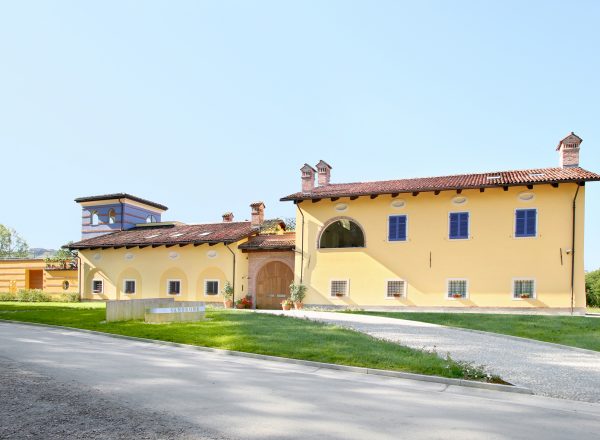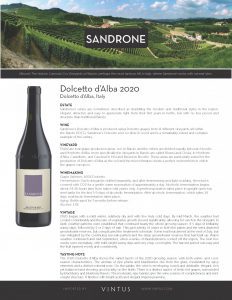
Sandrone
Dolcetto d’Alba 2020
Dolcetto d'Alba
Sandrone’s Dolcetto d’Alba is produced using Dolcetto grapes from 11 different vineyards, all within the Barolo DOCG. Sandrone’s Dolcetto sees no time in wood and is a remarkably robust and complex example of the variety.
VINEYARD

Sandrone Dolcetto d’Alba is produced using 100% Dolcetto grapes from some of Alba’s finest plots. There are four grape production areas, two in Barolo and the others are divided equally between Novello and Monforte d’Alba; more specifically the vineyards in Barolo are called Rivassi and Crosia;in Monforte d’Alba, Castelletto; and Cascina Pe Mol and Ravera in Novello. These areas are particularly suited for the production of Dolcetto d’Alba as the soil and the mesoclimates create a perfect environment in which the grapes can grow.
WINEMAKING

Each vineyard is vinified separately, and after destemming and light crushing, the must is covered with CO2 for a gentle warm maceration of approximately a day. Alcoholic fermentation begins about 24-36 hours later from native wild yeasts only. A gentle maceration takes place in upright open-top steel tanks for the first 5-9 days of alcoholic fermentation. After alcoholic fermentation, which takes 14 days, malolactic fermentation takes place.
VINTAGE

The year 2020 began with a mild winter, relatively dry and with few truly cold days. January was mostly sunny and work could begin in the vineyards on the pruning and cleaning of the trellises. Some snow and precipitation finally arrived in the middle of February. Late February warmed up and the tying of the fruiting canes became crucial as indications were for a precocious spring – the sap was moving at the end of the month.
Early March saw continued good weather, unseasonably warm and dry, leading to a quick push to finish the winter work.
By mid-March, the weather had cooled considerably and the rate of vegetative growth slowed significantly, allowing for catch in the vineyard. In April, weather patterns were established that continued nearly the whole growing season: 4-5 days of brilliantly sunny days, followed by 1 or 2 days of rain. This gave plenty of water to both the plants and the semi depleted groundwater reserves, but complicated the treatments schedule. The extra humidity brought on serious infections of Peronospora in the region. Luca’s long experience on dealing with this fungal infection allowed to keep ahead of the disease and saw no significant damage in 2020. Flowering in late May was under good conditions and brought a good crop set.
Some real heat arrived at the end of July, but was mitigated by the continuing sun-rain pattern and the deep groundwater reserves that had built up. Warm weather continued until mid-September, when a series of thunderstorms cooled off the region. The next few weeks were exemplary, with mild, bright sunny days and very crisp, cool nights. The harvest period was easy and the fruit ripened evenly and consistently.
Harvest took place from September 14tth until 21st.
TASTING NOTE

The 2020 Dolcetto d’Alba shows the varied facets of the 2020 growing season, with both warm- and cool season characteristics. The aromas of ripe plums and blackberries rise from the glass, modulated by spicy elements and a distinct mineral note.
On the palate, the wine is enveloping, round and drinkable, elegant, rich yet balanced and showing good acidity on the finish. There is a distinct aspect of fresh red grapes, surrounded by blackberry and blueberry flavors.
The moderate, ripe tannins give the wine a sense of completeness and mid-weight structure. It finishes with bright acids and elegant lingering tannins.
Color
Red
Appellation
Dolcetto d'Alba
Farming
Follows organic farming but has chosen not to seek certification. Minimal quantities of Bordeaux mixture and sulfur (as allowed per organic practices) are used to control mold and fungus, and fertilization every 4-6 years occurs with composted manure from dairy cows.
Alcohol
13.0%
Suggested Retail Price
$26.00
Reviews
"Bracing, taut Dolcetto"

Vinous - December 8, 2022 "The 2021 Dolcetto d'Alba is bright and punchy. Blue/purplish fruit, violets, spice, licorice and rose petal all meld together in this bracing, taut Dolcetto. This is an especially understated, super-classic style for Sandrone, and it works so well." -A.G 11/22
Trade Materials
Other Wines by this Producer

Le Vigne Barolo
Barolo
Le Vigne is a wine created from four different Nebbiolo vineyards, each of which brings its own contribution. This union generates an exceptionally complex wine that is round and harmonious on the palate, with fruity and spicy notes, and this approach of blending together plots is in fact the traditional one in Barolo.

Barbera d’Alba
Barbera d'Alba
The Sandrone Barbera d'Alba comes from three vineyards: Merli and Rocche di San Nicola in Novello, and Cascina Pe Mol in Monforte d’Alba. It is widely considered one of the most intense and complex Barberas produced.

Valmaggiore
Nebbiolo d'Alba
Valmaggiore is the product of Luciano’s incredible passion for the Nebbiolo grape variety and its different expression. Just 15 miles away from Barolo, in the Roero region, Nebbiolo produces a lighter structure and ripe, smooth tannins that are not unlike those of Pinot Noir. This is not a “baby Barolo” or a second wine at all – it is a distinct interpretation of Nebbiolo from a completely distinct geographic zone.

ALESTE Barolo
Barolo
A combination of the names of Luciano Sandrone's grandchildren ALEssia and STEfano, ALESTE is the new name for Luciano's first wine, the Barolo Cannubi Boschis, which garnered early acclaim with the international trade and press. This single-vineyard wine is typically dense and concentrated, but shows incredible harmony and balance.










